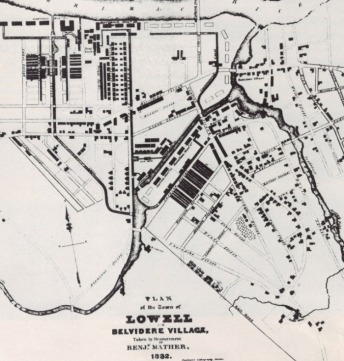Overview

Map of Lowell, Massachusetts
Beginning in the 1820s, textile mills started to emerge along the rivers of New England all the way down to the southern states, due to the invention of the power loom. “From the farms of Massachusetts, Vermont, New Hampshire, and Maine came robust young women, lured by the highest wages offered to female employees anywhere in America from $1.85 to $3.00 a week, depending on skill and speed.” [35] “Some of them were not over 10 years of age; a few were in the middle life, but the majority was between the ages of sixteen and twenty-five.” [36] From the 1820s to the 1860s, these girls came from the middling ranks of society until “1860, 61.8 of Lowell’s work force were immigrants, almost half of whom were Irish.” [37] The rest of the foreigners came over from Europe in pursuit of living a better life in America by earning money.
Until now, “Rural girls who had rarely seen-let alone owned-paper money could now enjoy the fruits of their labor in the Lowell mills.” [38] Not only that, but “Employment in the mills enabled women to enjoy social and economical independence unknown to their mothers’ generation.” [39] And, naturally, because “There really wasn’t much other work to do around” [40] thousands of girls took advantage of this opportunity.
However, not everything they encountered after that was as promising as they’d hoped. For example, when Susan Miller went to work in a mill, she was frightened by the sight of the new complex machines with all their parts in constant motion that she felt afraid to touch the loom and was almost sure that she’d never be capable of learning how to weave with one. [41] On the other hand, a young mill girl named Lucy Larcom described her work as being “…nothing but fun. It’s just like play.” [42] Mary Lou Emmons, a mill girl in the early 20th century said, “I did enjoy it while I was there” [43] and she found the living and working conditions to be quite tolerable. In addition to not minding the environment Mary Lou Emmons said that “Some people really liked having a job where they could go to every single day and not have to worry about whether or not they had enough money to pay their bills. But other people felt it was a very hard life because some of the jobs in the mills were a lot harder than others”. [44]
Until now, “Rural girls who had rarely seen-let alone owned-paper money could now enjoy the fruits of their labor in the Lowell mills.” [38] Not only that, but “Employment in the mills enabled women to enjoy social and economical independence unknown to their mothers’ generation.” [39] And, naturally, because “There really wasn’t much other work to do around” [40] thousands of girls took advantage of this opportunity.
However, not everything they encountered after that was as promising as they’d hoped. For example, when Susan Miller went to work in a mill, she was frightened by the sight of the new complex machines with all their parts in constant motion that she felt afraid to touch the loom and was almost sure that she’d never be capable of learning how to weave with one. [41] On the other hand, a young mill girl named Lucy Larcom described her work as being “…nothing but fun. It’s just like play.” [42] Mary Lou Emmons, a mill girl in the early 20th century said, “I did enjoy it while I was there” [43] and she found the living and working conditions to be quite tolerable. In addition to not minding the environment Mary Lou Emmons said that “Some people really liked having a job where they could go to every single day and not have to worry about whether or not they had enough money to pay their bills. But other people felt it was a very hard life because some of the jobs in the mills were a lot harder than others”. [44]
